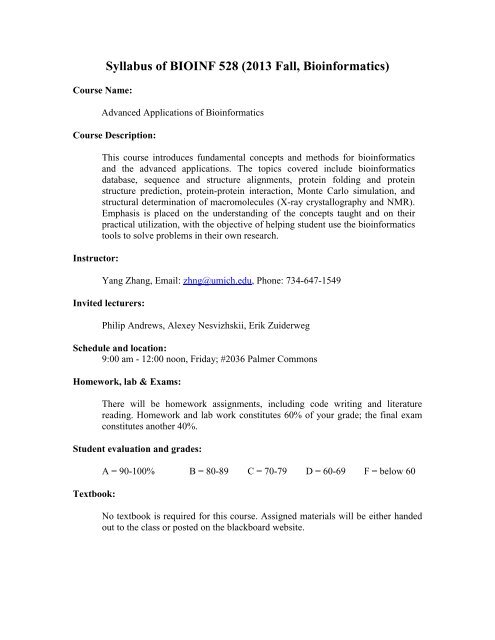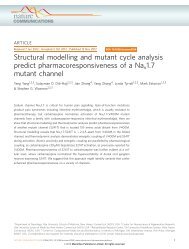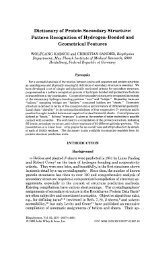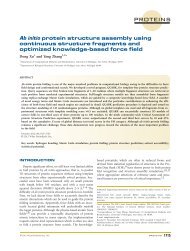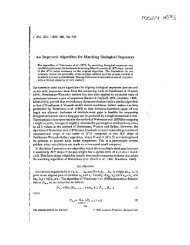Syllabus PDF - The Yang Zhang Lab
Syllabus PDF - The Yang Zhang Lab
Syllabus PDF - The Yang Zhang Lab
You also want an ePaper? Increase the reach of your titles
YUMPU automatically turns print PDFs into web optimized ePapers that Google loves.
Course Name:<br />
<strong>Syllabus</strong> of BIOINF 528 (2013 Fall, Bioinformatics)<br />
Advanced Applications of Bioinformatics<br />
Course Description:<br />
Instructor:<br />
This course introduces fundamental concepts and methods for bioinformatics<br />
and the advanced applications. <strong>The</strong> topics covered include bioinformatics<br />
database, sequence and structure alignments, protein folding and protein<br />
structure prediction, protein-protein interaction, Monte Carlo simulation, and<br />
structural determination of macromolecules (X-ray crystallography and NMR).<br />
Emphasis is placed on the understanding of the concepts taught and on their<br />
practical utilization, with the objective of helping student use the bioinformatics<br />
tools to solve problems in their own research.<br />
<strong>Yang</strong> <strong>Zhang</strong>, Email: zhng@umich.edu, Phone: 734-647-1549<br />
Invited lecturers:<br />
Philip Andrews, Alexey Nesvizhskii, Erik Zuiderweg<br />
Schedule and location:<br />
9:00 am - 12:00 noon, Friday; #2036 Palmer Commons<br />
Homework, lab & Exams:<br />
<strong>The</strong>re will be homework assignments, including code writing and literature<br />
reading. Homework and lab work constitutes 60% of your grade; the final exam<br />
constitutes another 40%.<br />
Student evaluation and grades:<br />
Textbook:<br />
A = 90-100% B = 80-89 C = 70-79 D = 60-69 F = below 60<br />
No textbook is required for this course. Assigned materials will be either handed<br />
out to the class or posted on the blackboard website.
PART I: BIOINFORMATICS BASICS<br />
Table of content<br />
1. Bioinformatics databases<br />
1.1. Introduction<br />
1.1.1. Motivation<br />
1.1.2. Type of databases<br />
1.2. Nucleotide sequence databases<br />
1.2.1. Primary nucleotide sequence databases<br />
1.2.1.1.EMBL<br />
1.2.1.2.GeneBank<br />
1.2.1.3.DDBJ<br />
1.2.2. Secondary nucleotide sequence databases<br />
1.2.2.1.UniGene<br />
1.2.2.2.SGD<br />
1.2.2.3.EMI Genomes<br />
1.2.2.4.Genome Biology<br />
1.3. Protein sequence databases<br />
1.3.1. How protein sequences are determined<br />
1.3.1.1. DNA/mRNA coding<br />
1.3.1.2. Edman degradation rection<br />
1.3.1.3. Mass spectrometry<br />
1.3.2. SwissProt/TrEMBL<br />
1.3.3. PIR<br />
1.3.4. UniProt<br />
1.4. Protein structure databases<br />
1.4.1. Protein Data Bank<br />
1.4.2. SCOP<br />
1.4.3. CATH<br />
1.5. Other relevant databases<br />
1.5.1. Pfam<br />
1.5.2. KEGG<br />
1.5.3. PROSITE<br />
1.5.4. BioLiP<br />
2. Sequence alignment and database searching<br />
2.1. Pair-wise sequence alignments<br />
2.1.1. Biological motivation<br />
2.1.2. Pairwise alignments<br />
2.1.2.1.Scoring matrix<br />
2.1.2.1.1. PAM<br />
2.1.2.1.2. BLOSUM<br />
2.1.2.2.Gap penalty<br />
2.1.3. Dynamics programming<br />
2.1.3.1.Needleman-Wunsch<br />
2.1.3.2.Smith-Waterman
2.1.4. Heuristic methods<br />
2.1.4.1.FASTA<br />
2.1.4.2.BLAST<br />
2.1.5. Statistics of sequence alignment score<br />
2.1.5.1.E-Value<br />
2.1.5.2.P-Value<br />
2.2. Multiple sequence alignments<br />
2.2.1. Neighbor-joining method and phylogenetic tree<br />
2.2.2. ClustalW<br />
2.2.3. Sequence profile<br />
2.2.3.1.Profile-sequence alignment<br />
2.2.3.2.Profile-profile alignment<br />
2.2.4. PSI-BLAST<br />
2.2.5. Hidden Markov Models<br />
2.2.5.1.Viterbi algorithm<br />
2.2.5.2.HMM based multiple-sequence alignment<br />
2.2.5.2.1. HMMER<br />
2.2.5.2.2. HHpred<br />
3. Protein structure alignments<br />
3.1. What is structure superposition?<br />
3.1.1. RMSD<br />
3.1.2. TM-score<br />
3.2. What is structure alignment?<br />
3.3. Different structure alignment algorithms<br />
3.3.1. DALI<br />
3.3.2. CE<br />
3.3.3. TM-align<br />
3.4. Number of protein folds in PDB<br />
PART II: PROTEIN FOLDING AND PROTEIN-PROTEIN INTERACTIONS<br />
4. Monte Carlo Simulation<br />
4.1. Introduction: why Monte Carlo simulation?<br />
4.2. Monte Carlo Sampling of Probabilities<br />
4.2.1. Random number generator<br />
4.2.2. Sampling of rectangular distributions<br />
4.2.3. Sampling of probability distribution<br />
4.2.3.1.Inverse transform method<br />
4.2.3.2.Accept-Rejection method<br />
4.3. Metropolis method<br />
4.4. Advanced Metropolis methods<br />
4.4.1. Simulated annealing<br />
4.4.2. Replica exchange simulation<br />
5. Protein secondary structure predictions<br />
5.1. What is protein secondary structure?<br />
5.2. Hydrogen bond
5.3. How to define a secondary structure element?<br />
5.4. Methods for predicting secondary structure<br />
5.4.1. Chou and Fasman method<br />
5.4.2. PHD<br />
5.4.3. PSIPRED<br />
6. Protein tertiary structure modeling<br />
6.1. Basic concepts<br />
6.2. Comparative modeling<br />
6.2.1. Modeller<br />
6.3. Threading and fold-recognition<br />
6.3.1. What is threading?<br />
6.3.2. Bowie-Luthy-Eisenberg<br />
6.3.3. Profile-profile alignments<br />
6.3.4. Threading programs<br />
6.3.4.1.HHpred<br />
6.3.4.2.FFAS03<br />
6.3.4.3.PROSPECTOR<br />
6.3.4.4.MUSTER<br />
6.3.5. Meta-server threading<br />
6.3.5.1.3D-jury<br />
6.3.5.2.LOMETS<br />
6.4. Ab initio modeling<br />
6.4.1. Anfinsen thermodynamic hypothesis<br />
6.4.2. Molecular dynamics simulation<br />
6.4.2.1.CHARMM<br />
6.4.2.2.AMBER<br />
6.4.3. Knowledge-based free modeling<br />
6.4.3.1.ROSETTA<br />
6.4.3.2.TOUCHSTONE<br />
6.4.3.3.QUARK<br />
6.5. Combined modeling approaches<br />
6.5.1. TASSER/I-TASSER<br />
6.6. CASP: A blind test on protein structure predictions<br />
7. Principle of X-ray Crystallography & Molecular Replacement<br />
7.1. What is X-ray Crystallography<br />
7.2. Why can a wave be represented by exp(iα) ?<br />
7.3. How to calculate scattering on two electrons?<br />
7.4. What is Laue condition?<br />
7.5. What is Bragg’s law?<br />
7.6. How to calculate electron density of crystal?<br />
7.7. What is Patterson function?<br />
7.8. How to calculate electron density of crystal?<br />
7.9. What is the idea of Molecular Replacement?<br />
7.10. How to judge quality of MR?<br />
7.11. What are often-used software for MR?<br />
8. NMR spectroscopy for protein structure determination (Prof. Erik Zuiderweg)
8.1. What is NMR?<br />
8.2. <strong>The</strong> Chemical shift<br />
8.3. <strong>The</strong> structural shift<br />
8.4. Structures by NMR<br />
8.5. Secondary structure by NOE<br />
8.6. Agreement of solution and crystal<br />
8.7. Protein dynamics and NMR<br />
8.8. Dynamics and entropy<br />
9. Protein function and structure-based function annotation<br />
9.1. Gene ontology<br />
9.2. Enzyme classification<br />
9.3. Ligand-protein interaction<br />
9.4. Structure-based function annotation<br />
9.4.1. FindSite<br />
9.4.2. COFACTOR<br />
9.4.3. COACH<br />
10. Modeling of protein-protein interactions<br />
10.1. Experimental identification of protein-protein interactions<br />
10.1.1. Yeast two-hybrid assay<br />
10.1.2. High-throughput mass spectrometry<br />
10.1.3. Interaction networks and system biology<br />
10.2. Protein-protein quaternary structure modeling<br />
10.2.1. Basic concepts<br />
10.2.1.1. Degrees of freedom<br />
10.2.1.2. Presentation of protein conformations<br />
10.2.1.3. Hydrophobicity factor<br />
10.2.1.4. Shape complementary<br />
10.2.1.5. Docking Scoring function<br />
10.2.2. Protein-protein docking algorithms<br />
10.2.2.1. Fast Fourier Transformation (FFT)<br />
10.2.2.2. Semi-flexible docking: Side-chain refinement<br />
10.2.2.3. Clustering and refinement<br />
10.2.3. Homology modeling<br />
10.2.4. Multiple-chain threading<br />
10.2.4.1. COTH<br />
10.2.4.2. SPRING<br />
10.2.5. Monte Carlo docking simulation<br />
10.2.6. CAPRI: A blind test on protein-protein docking<br />
PART III: Selected Topics (by invited speakers)<br />
Prof. Philip Andrews: (10/4)<br />
Introduction to mass spectrometry<br />
Prof. Alexey I. Nesvizhskii: (11/8)<br />
Protein-protein network and complex<br />
Prof. Erik Zuiderweg: (9/27)
NMR spectroscopy for protein structure determination


